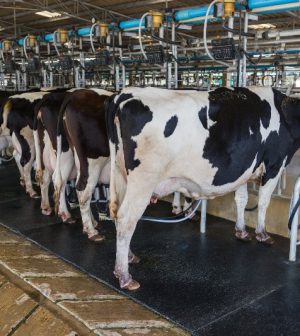- Navigating Your Midlife Crisis: Embracing New Possibilities
- City Raccoons Showing Signs of Domestication
- Mapping the Exposome: Science Broadens Focus to Environmental Disease Triggers
- One Week Less on Social Media Linked to Better Mental Health
- Your Brain Changes in Stages as You Age, Study Finds
- Some Suicide Victims Show No Typical Warning Signs, Study Finds
- ByHeart Formula Faces Lawsuits After Babies Sickened With Botulism
- Switch to Vegan Diet Could Cut Your Greenhouse Gas Emissions in Half
- Regular Bedtime Does Wonders for Blood Pressure
- Dining Alone Could Mean Worse Nutrition for Seniors
FDA Says First Round of Tests Show No Live Virus in Pasteurized Milk

Live bird flu virus has not been found in any of the first batch of retail milk samples tested, federal health officials said Friday.
Amid an ongoing outbreak of bird flu in U.S. dairy cows, the early findings should reassure the public that the milk sold in stores remains safe, officials added.
In the online update, the U.S. Food and Drug Administration said the initial test findings likely mean the pasteurization process is killing the virus.
“These results reaffirm our assessment that the commercial milk supply is safe,” the agency wrote, but testing efforts are continuing.
“The FDA is further assessing retail samples from its study of 297 samples of retail dairy products from 38 states,” the agency added. “All samples with a PCR-positive result are going through egg inoculation tests, a gold standard for determining if infectious virus is present.”
“These important efforts are ongoing, and we are committed to sharing additional testing results as soon as possible,” the FDA added.
FDA officials also tested infant and toddler formulas, which used powdered milk, and did not find any evidence of the virus, the agency noted.
The story is different when it comes to viral fragments of bird flu: genetic bits of the virus have been discovered in roughly 20% of retail milk samples tested in a national survey, the U.S. Food and Drug Administration said last week.
That earlier finding suggests bird flu has spread far more widely among dairy cows than officials first thought.
Samples from parts of the country that have infected dairy herds were more likely to test positive, the agency noted, and regulators stressed there is no evidence yet that cow milk poses a danger to consumers.
Still, 33 herds across eight states have been confirmed to have been infected with bird flu, also known as H5N1.
“It suggests that there is a whole lot of this virus out there,” Richard Webby, a virologist and influenza expert at St. Jude Children’s Research Hospital, told the New York Times.
While it is still possible to eradicate bird flu from the nation’s dairy farms, Webby noted it is hard to control the outbreak without knowing its full scope.
To that end, the U.S. Department of Agriculture on Wednesday announced mandatory testing of dairy cows moving across state lines. Until now, testing of cows had been voluntary and focused on cows with obvious symptoms of illness.
As of Wednesday, 23 people had been tested for the virus, while 44 people were being monitored after exposure to H5N1, the Times reported. Just one human infection has been reported so far, in a dairy worker in Texas who had direct contact with sick cows. The case was mild.
Still, sustained spread among cows would give the virus more chances to become more transmissible among humans.
Experts believe pasteurization, in which milk is briefly heated, should kill the virus.
“And when you destroy the virus, it’s going to release genetic material,” Samuel Alcaine, a microbiologist and food scientist at Cornell University in New York, told the Times.
“It’s not surprising” to find them in milk, he added. “It doesn’t mean that the milk is not safe.”
Dr. Jeanne Marrazzo, director of the National Institute of Allergy and Infectious Diseases, said during a Wednesday media briefing that some researchers had tested for live virus in retail milk but didn’t find any, the Times reported.
Even though the results only involved a small sample, the findings were “welcome news,” she added.
Still, “to really understand the scope here, we need to wait for the FDA efforts,” she noted.
More information
The U.S. Centers for Disease Control and Prevention has more on bird flu.
SOURCES: U.S. Food and Drug Administration, updates, April 25/26, 2024; New York Times
Source: HealthDay
Copyright © 2025 HealthDay. All rights reserved.










